Westminster Homecare: Total Quality Management in Operations Report
VerifiedAdded on 2023/01/11
|12
|4031
|83
Report
AI Summary
This report provides an in-depth analysis of the operational management of Westminster Homecare, a company providing home-care services. It examines the application of total quality management to identify areas for improvement, particularly focusing on the challenges associated with chemotherapy administration at home. The report details the company's services, operational processes, and the issues arising from personalized drug preparation and delivery. It highlights problems such as the risk of errors, potential for infection, and logistical complexities. The report includes recommendations for the management of Westminster Homecare to enhance efficiency and improve the quality of care, considering the guidelines for separate drug preparation units. The report also discusses the need for improved scheduling, resource allocation, and the importance of addressing issues related to funding and healthcare supply within the home-care setting.
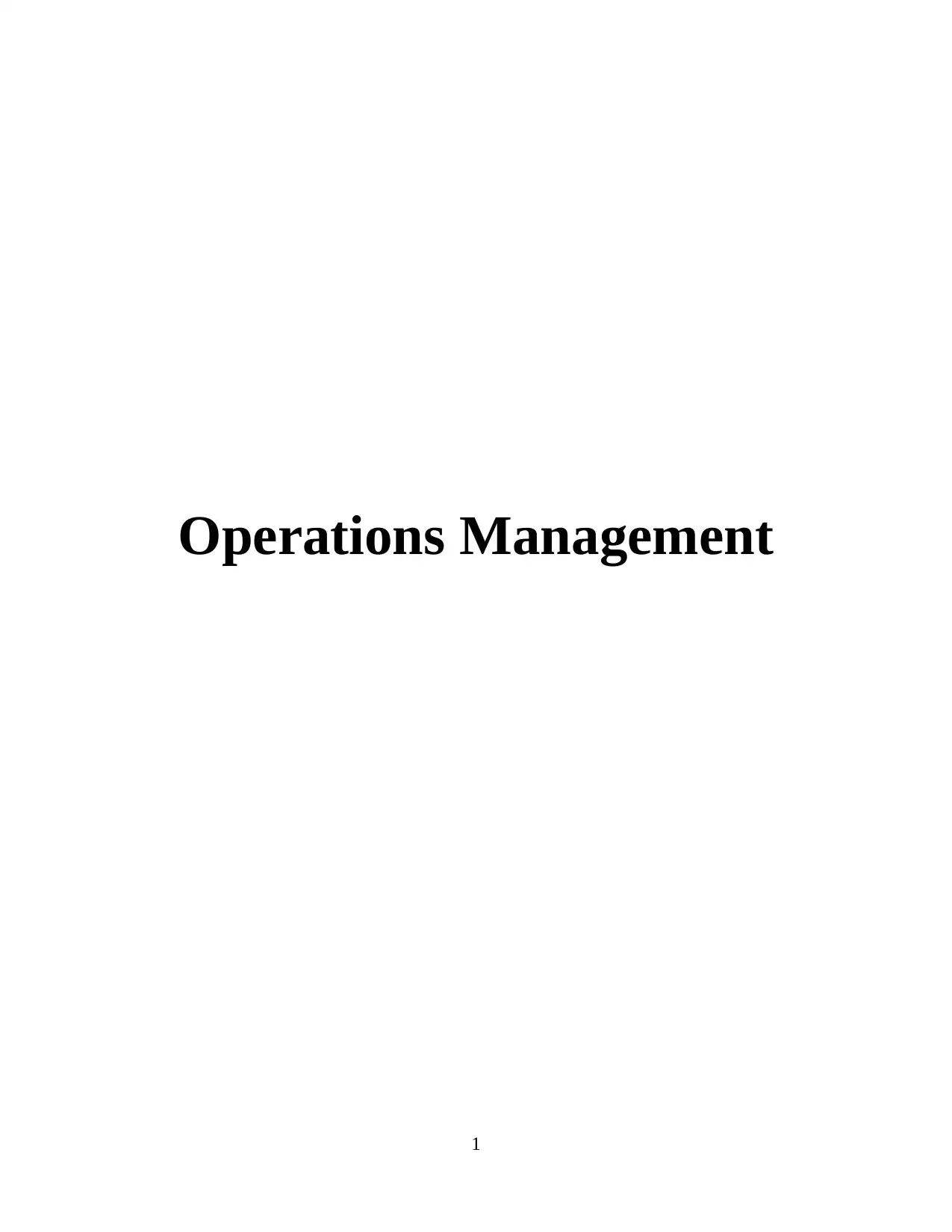
Operations Management
1
1
Secure Best Marks with AI Grader
Need help grading? Try our AI Grader for instant feedback on your assignments.
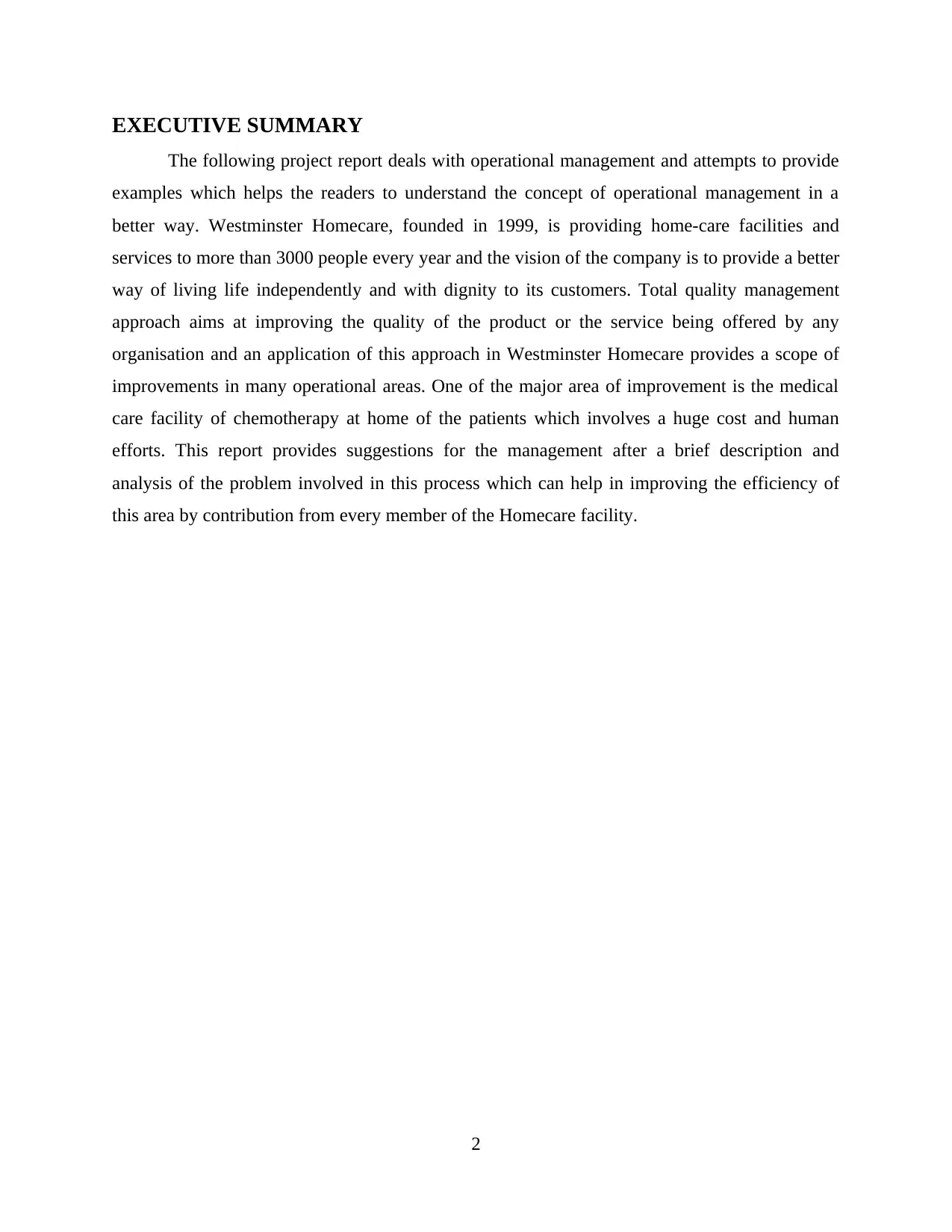
EXECUTIVE SUMMARY
The following project report deals with operational management and attempts to provide
examples which helps the readers to understand the concept of operational management in a
better way. Westminster Homecare, founded in 1999, is providing home-care facilities and
services to more than 3000 people every year and the vision of the company is to provide a better
way of living life independently and with dignity to its customers. Total quality management
approach aims at improving the quality of the product or the service being offered by any
organisation and an application of this approach in Westminster Homecare provides a scope of
improvements in many operational areas. One of the major area of improvement is the medical
care facility of chemotherapy at home of the patients which involves a huge cost and human
efforts. This report provides suggestions for the management after a brief description and
analysis of the problem involved in this process which can help in improving the efficiency of
this area by contribution from every member of the Homecare facility.
2
The following project report deals with operational management and attempts to provide
examples which helps the readers to understand the concept of operational management in a
better way. Westminster Homecare, founded in 1999, is providing home-care facilities and
services to more than 3000 people every year and the vision of the company is to provide a better
way of living life independently and with dignity to its customers. Total quality management
approach aims at improving the quality of the product or the service being offered by any
organisation and an application of this approach in Westminster Homecare provides a scope of
improvements in many operational areas. One of the major area of improvement is the medical
care facility of chemotherapy at home of the patients which involves a huge cost and human
efforts. This report provides suggestions for the management after a brief description and
analysis of the problem involved in this process which can help in improving the efficiency of
this area by contribution from every member of the Homecare facility.
2
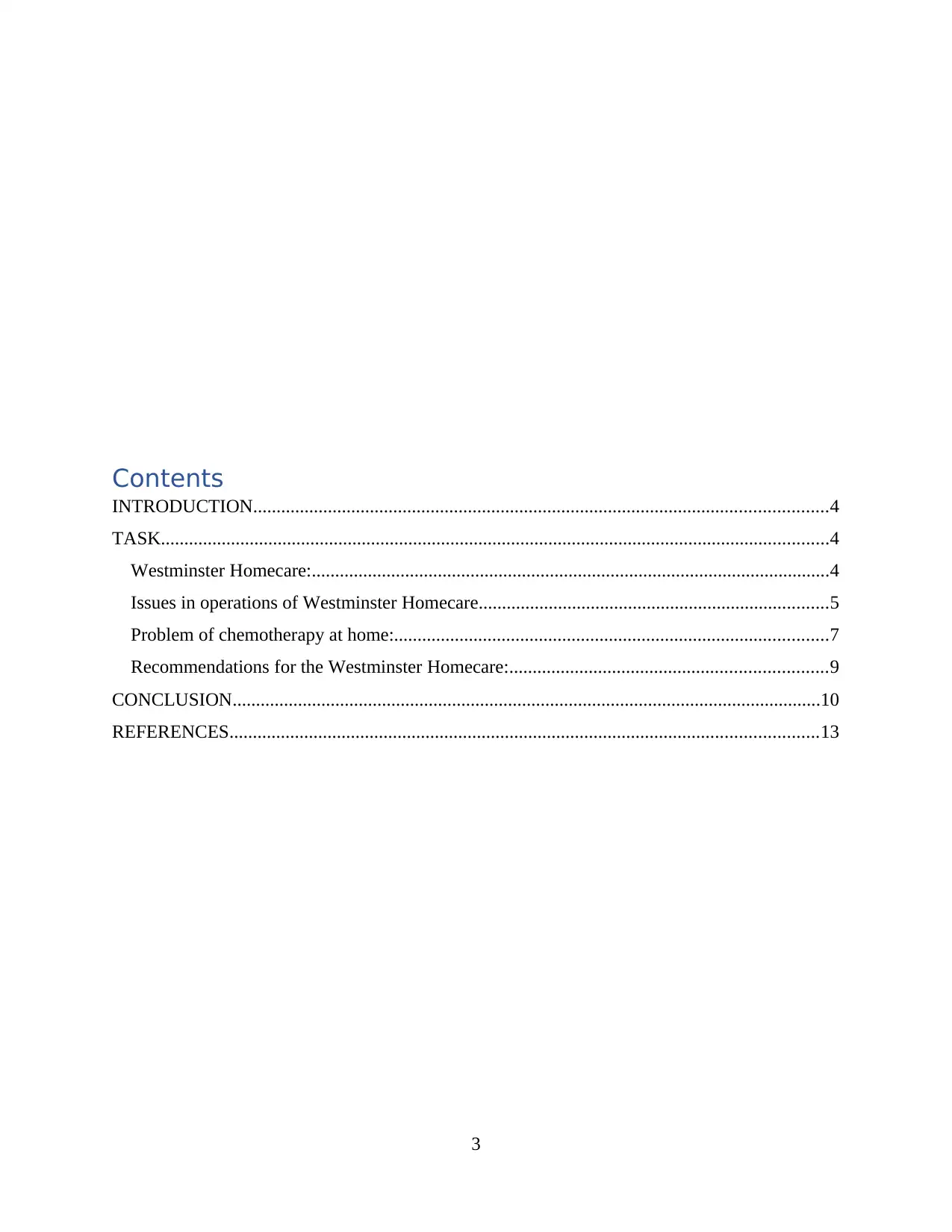
Contents
INTRODUCTION...........................................................................................................................4
TASK...............................................................................................................................................4
Westminster Homecare:...............................................................................................................4
Issues in operations of Westminster Homecare...........................................................................5
Problem of chemotherapy at home:.............................................................................................7
Recommendations for the Westminster Homecare:....................................................................9
CONCLUSION..............................................................................................................................10
REFERENCES..............................................................................................................................13
3
INTRODUCTION...........................................................................................................................4
TASK...............................................................................................................................................4
Westminster Homecare:...............................................................................................................4
Issues in operations of Westminster Homecare...........................................................................5
Problem of chemotherapy at home:.............................................................................................7
Recommendations for the Westminster Homecare:....................................................................9
CONCLUSION..............................................................................................................................10
REFERENCES..............................................................................................................................13
3
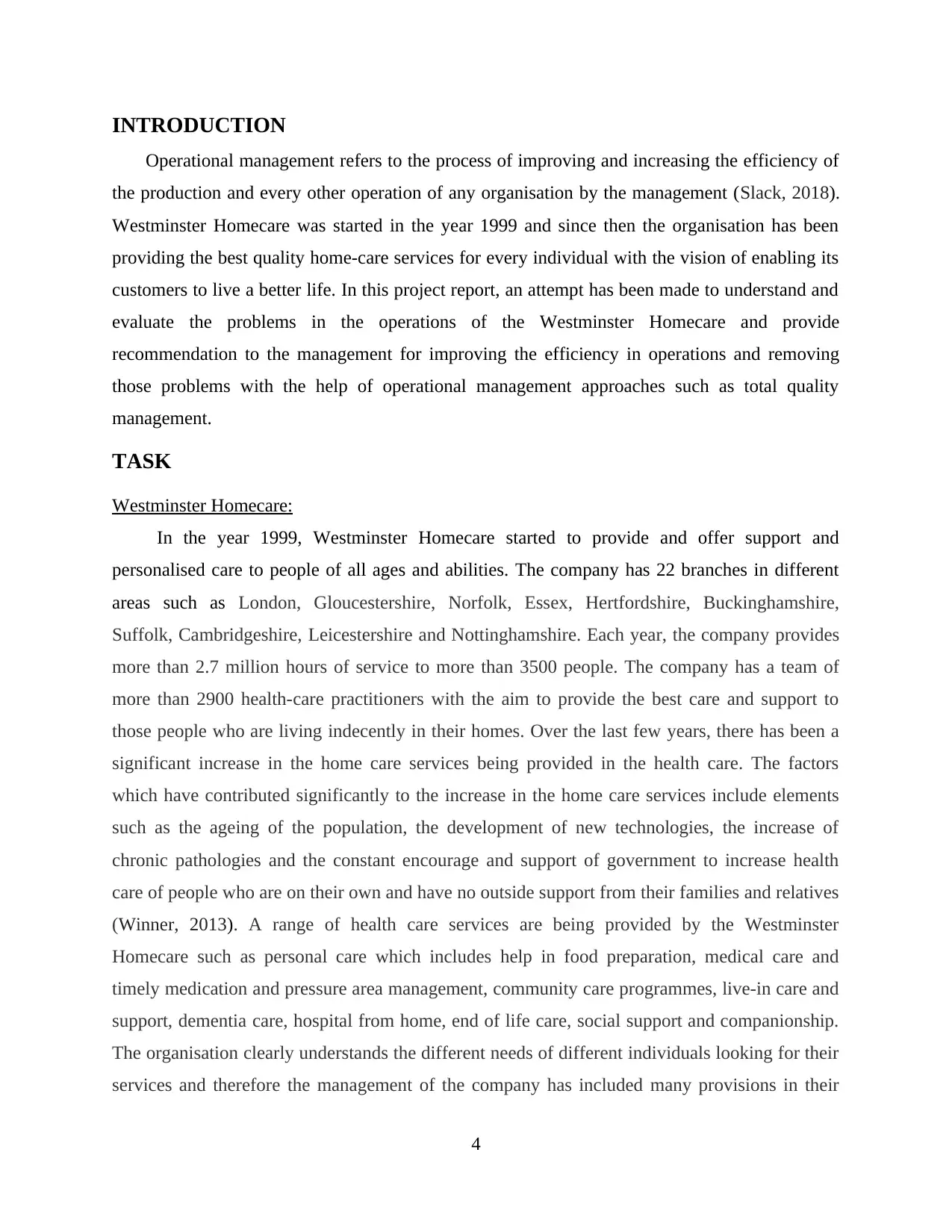
INTRODUCTION
Operational management refers to the process of improving and increasing the efficiency of
the production and every other operation of any organisation by the management (Slack, 2018).
Westminster Homecare was started in the year 1999 and since then the organisation has been
providing the best quality home-care services for every individual with the vision of enabling its
customers to live a better life. In this project report, an attempt has been made to understand and
evaluate the problems in the operations of the Westminster Homecare and provide
recommendation to the management for improving the efficiency in operations and removing
those problems with the help of operational management approaches such as total quality
management.
TASK
Westminster Homecare:
In the year 1999, Westminster Homecare started to provide and offer support and
personalised care to people of all ages and abilities. The company has 22 branches in different
areas such as London, Gloucestershire, Norfolk, Essex, Hertfordshire, Buckinghamshire,
Suffolk, Cambridgeshire, Leicestershire and Nottinghamshire. Each year, the company provides
more than 2.7 million hours of service to more than 3500 people. The company has a team of
more than 2900 health-care practitioners with the aim to provide the best care and support to
those people who are living indecently in their homes. Over the last few years, there has been a
significant increase in the home care services being provided in the health care. The factors
which have contributed significantly to the increase in the home care services include elements
such as the ageing of the population, the development of new technologies, the increase of
chronic pathologies and the constant encourage and support of government to increase health
care of people who are on their own and have no outside support from their families and relatives
(Winner, 2013). A range of health care services are being provided by the Westminster
Homecare such as personal care which includes help in food preparation, medical care and
timely medication and pressure area management, community care programmes, live-in care and
support, dementia care, hospital from home, end of life care, social support and companionship.
The organisation clearly understands the different needs of different individuals looking for their
services and therefore the management of the company has included many provisions in their
4
Operational management refers to the process of improving and increasing the efficiency of
the production and every other operation of any organisation by the management (Slack, 2018).
Westminster Homecare was started in the year 1999 and since then the organisation has been
providing the best quality home-care services for every individual with the vision of enabling its
customers to live a better life. In this project report, an attempt has been made to understand and
evaluate the problems in the operations of the Westminster Homecare and provide
recommendation to the management for improving the efficiency in operations and removing
those problems with the help of operational management approaches such as total quality
management.
TASK
Westminster Homecare:
In the year 1999, Westminster Homecare started to provide and offer support and
personalised care to people of all ages and abilities. The company has 22 branches in different
areas such as London, Gloucestershire, Norfolk, Essex, Hertfordshire, Buckinghamshire,
Suffolk, Cambridgeshire, Leicestershire and Nottinghamshire. Each year, the company provides
more than 2.7 million hours of service to more than 3500 people. The company has a team of
more than 2900 health-care practitioners with the aim to provide the best care and support to
those people who are living indecently in their homes. Over the last few years, there has been a
significant increase in the home care services being provided in the health care. The factors
which have contributed significantly to the increase in the home care services include elements
such as the ageing of the population, the development of new technologies, the increase of
chronic pathologies and the constant encourage and support of government to increase health
care of people who are on their own and have no outside support from their families and relatives
(Winner, 2013). A range of health care services are being provided by the Westminster
Homecare such as personal care which includes help in food preparation, medical care and
timely medication and pressure area management, community care programmes, live-in care and
support, dementia care, hospital from home, end of life care, social support and companionship.
The organisation clearly understands the different needs of different individuals looking for their
services and therefore the management of the company has included many provisions in their
4
Secure Best Marks with AI Grader
Need help grading? Try our AI Grader for instant feedback on your assignments.
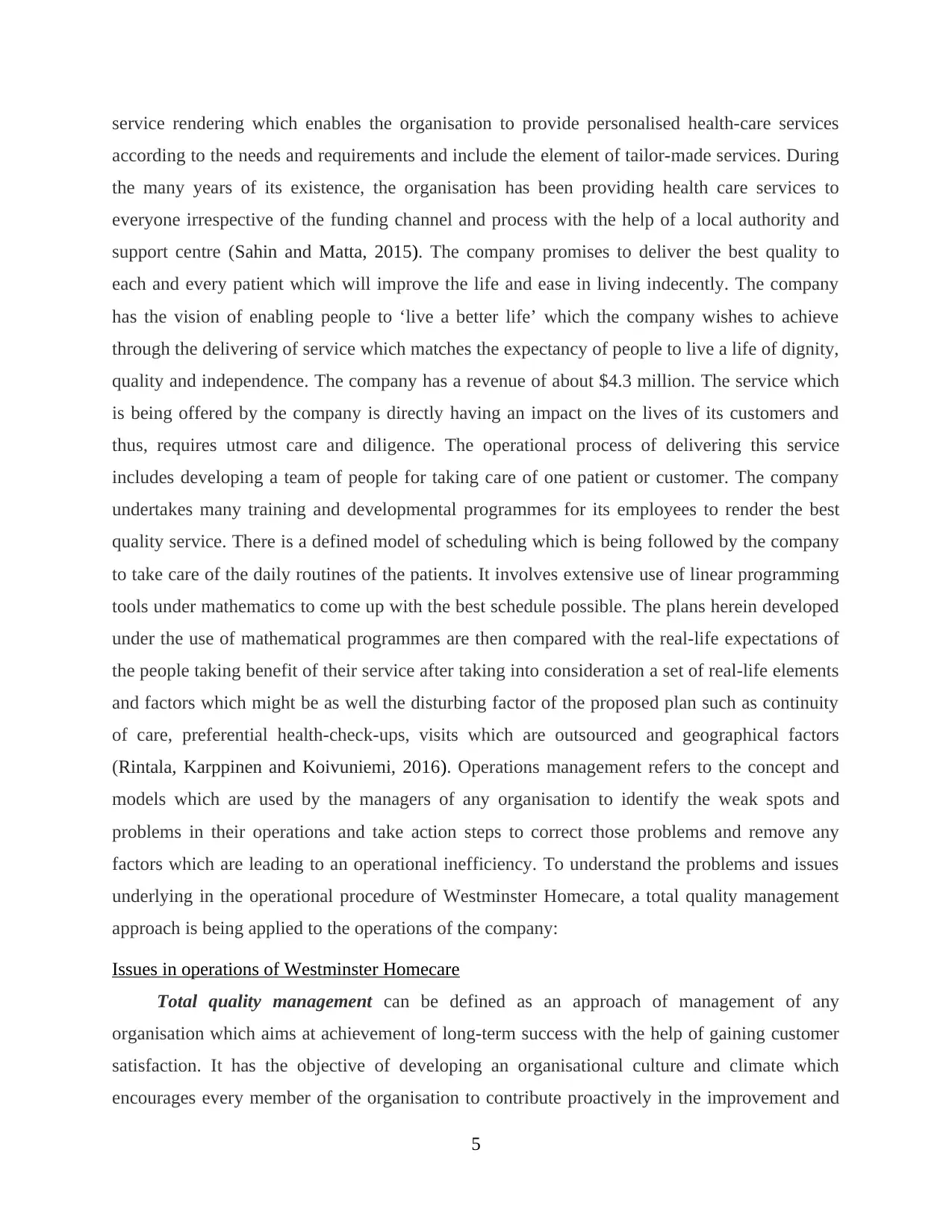
service rendering which enables the organisation to provide personalised health-care services
according to the needs and requirements and include the element of tailor-made services. During
the many years of its existence, the organisation has been providing health care services to
everyone irrespective of the funding channel and process with the help of a local authority and
support centre (Sahin and Matta, 2015). The company promises to deliver the best quality to
each and every patient which will improve the life and ease in living indecently. The company
has the vision of enabling people to ‘live a better life’ which the company wishes to achieve
through the delivering of service which matches the expectancy of people to live a life of dignity,
quality and independence. The company has a revenue of about $4.3 million. The service which
is being offered by the company is directly having an impact on the lives of its customers and
thus, requires utmost care and diligence. The operational process of delivering this service
includes developing a team of people for taking care of one patient or customer. The company
undertakes many training and developmental programmes for its employees to render the best
quality service. There is a defined model of scheduling which is being followed by the company
to take care of the daily routines of the patients. It involves extensive use of linear programming
tools under mathematics to come up with the best schedule possible. The plans herein developed
under the use of mathematical programmes are then compared with the real-life expectations of
the people taking benefit of their service after taking into consideration a set of real-life elements
and factors which might be as well the disturbing factor of the proposed plan such as continuity
of care, preferential health-check-ups, visits which are outsourced and geographical factors
(Rintala, Karppinen and Koivuniemi, 2016). Operations management refers to the concept and
models which are used by the managers of any organisation to identify the weak spots and
problems in their operations and take action steps to correct those problems and remove any
factors which are leading to an operational inefficiency. To understand the problems and issues
underlying in the operational procedure of Westminster Homecare, a total quality management
approach is being applied to the operations of the company:
Issues in operations of Westminster Homecare
Total quality management can be defined as an approach of management of any
organisation which aims at achievement of long-term success with the help of gaining customer
satisfaction. It has the objective of developing an organisational culture and climate which
encourages every member of the organisation to contribute proactively in the improvement and
5
according to the needs and requirements and include the element of tailor-made services. During
the many years of its existence, the organisation has been providing health care services to
everyone irrespective of the funding channel and process with the help of a local authority and
support centre (Sahin and Matta, 2015). The company promises to deliver the best quality to
each and every patient which will improve the life and ease in living indecently. The company
has the vision of enabling people to ‘live a better life’ which the company wishes to achieve
through the delivering of service which matches the expectancy of people to live a life of dignity,
quality and independence. The company has a revenue of about $4.3 million. The service which
is being offered by the company is directly having an impact on the lives of its customers and
thus, requires utmost care and diligence. The operational process of delivering this service
includes developing a team of people for taking care of one patient or customer. The company
undertakes many training and developmental programmes for its employees to render the best
quality service. There is a defined model of scheduling which is being followed by the company
to take care of the daily routines of the patients. It involves extensive use of linear programming
tools under mathematics to come up with the best schedule possible. The plans herein developed
under the use of mathematical programmes are then compared with the real-life expectations of
the people taking benefit of their service after taking into consideration a set of real-life elements
and factors which might be as well the disturbing factor of the proposed plan such as continuity
of care, preferential health-check-ups, visits which are outsourced and geographical factors
(Rintala, Karppinen and Koivuniemi, 2016). Operations management refers to the concept and
models which are used by the managers of any organisation to identify the weak spots and
problems in their operations and take action steps to correct those problems and remove any
factors which are leading to an operational inefficiency. To understand the problems and issues
underlying in the operational procedure of Westminster Homecare, a total quality management
approach is being applied to the operations of the company:
Issues in operations of Westminster Homecare
Total quality management can be defined as an approach of management of any
organisation which aims at achievement of long-term success with the help of gaining customer
satisfaction. It has the objective of developing an organisational culture and climate which
encourages every member of the organisation to contribute proactively in the improvement and
5
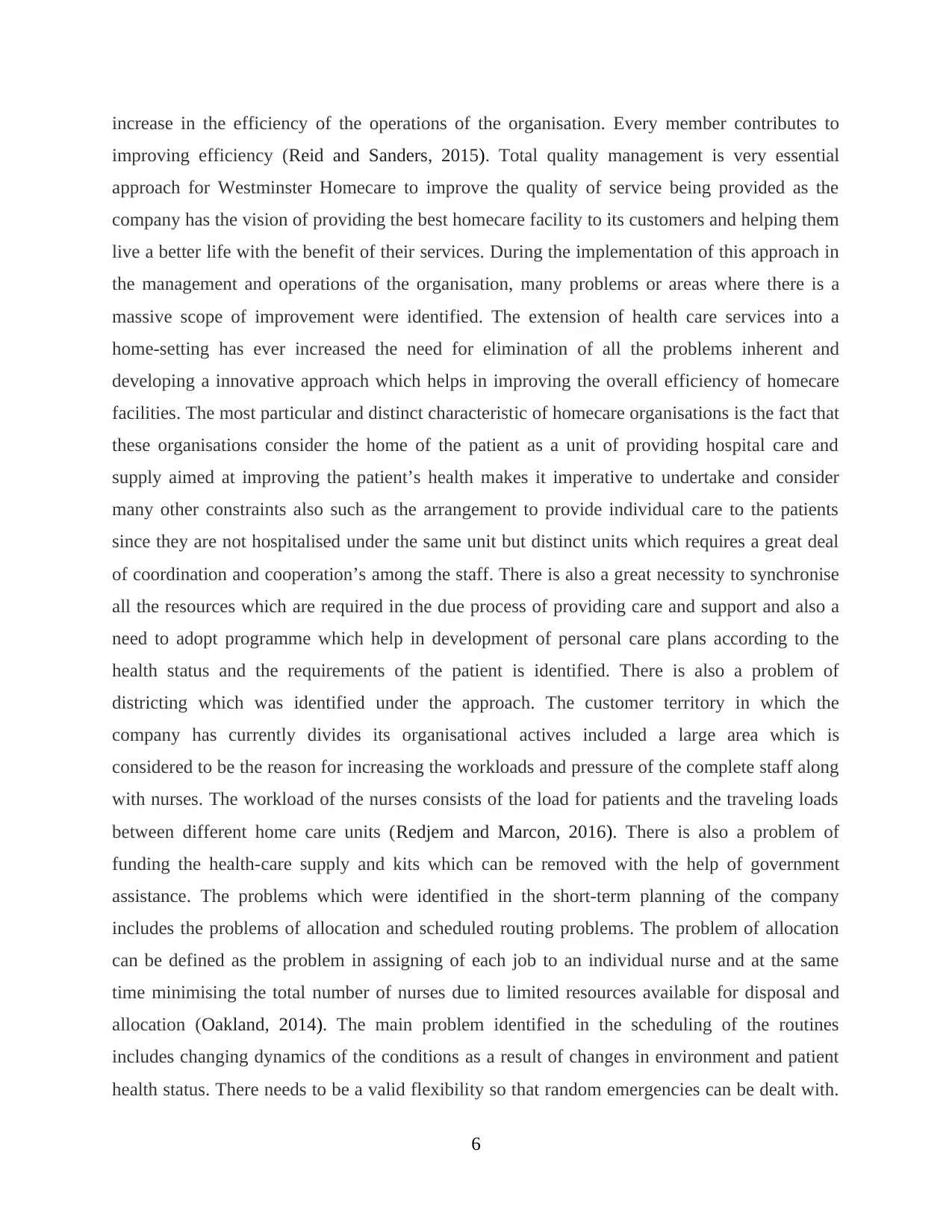
increase in the efficiency of the operations of the organisation. Every member contributes to
improving efficiency (Reid and Sanders, 2015). Total quality management is very essential
approach for Westminster Homecare to improve the quality of service being provided as the
company has the vision of providing the best homecare facility to its customers and helping them
live a better life with the benefit of their services. During the implementation of this approach in
the management and operations of the organisation, many problems or areas where there is a
massive scope of improvement were identified. The extension of health care services into a
home-setting has ever increased the need for elimination of all the problems inherent and
developing a innovative approach which helps in improving the overall efficiency of homecare
facilities. The most particular and distinct characteristic of homecare organisations is the fact that
these organisations consider the home of the patient as a unit of providing hospital care and
supply aimed at improving the patient’s health makes it imperative to undertake and consider
many other constraints also such as the arrangement to provide individual care to the patients
since they are not hospitalised under the same unit but distinct units which requires a great deal
of coordination and cooperation’s among the staff. There is also a great necessity to synchronise
all the resources which are required in the due process of providing care and support and also a
need to adopt programme which help in development of personal care plans according to the
health status and the requirements of the patient is identified. There is also a problem of
districting which was identified under the approach. The customer territory in which the
company has currently divides its organisational actives included a large area which is
considered to be the reason for increasing the workloads and pressure of the complete staff along
with nurses. The workload of the nurses consists of the load for patients and the traveling loads
between different home care units (Redjem and Marcon, 2016). There is also a problem of
funding the health-care supply and kits which can be removed with the help of government
assistance. The problems which were identified in the short-term planning of the company
includes the problems of allocation and scheduled routing problems. The problem of allocation
can be defined as the problem in assigning of each job to an individual nurse and at the same
time minimising the total number of nurses due to limited resources available for disposal and
allocation (Oakland, 2014). The main problem identified in the scheduling of the routines
includes changing dynamics of the conditions as a result of changes in environment and patient
health status. There needs to be a valid flexibility so that random emergencies can be dealt with.
6
improving efficiency (Reid and Sanders, 2015). Total quality management is very essential
approach for Westminster Homecare to improve the quality of service being provided as the
company has the vision of providing the best homecare facility to its customers and helping them
live a better life with the benefit of their services. During the implementation of this approach in
the management and operations of the organisation, many problems or areas where there is a
massive scope of improvement were identified. The extension of health care services into a
home-setting has ever increased the need for elimination of all the problems inherent and
developing a innovative approach which helps in improving the overall efficiency of homecare
facilities. The most particular and distinct characteristic of homecare organisations is the fact that
these organisations consider the home of the patient as a unit of providing hospital care and
supply aimed at improving the patient’s health makes it imperative to undertake and consider
many other constraints also such as the arrangement to provide individual care to the patients
since they are not hospitalised under the same unit but distinct units which requires a great deal
of coordination and cooperation’s among the staff. There is also a great necessity to synchronise
all the resources which are required in the due process of providing care and support and also a
need to adopt programme which help in development of personal care plans according to the
health status and the requirements of the patient is identified. There is also a problem of
districting which was identified under the approach. The customer territory in which the
company has currently divides its organisational actives included a large area which is
considered to be the reason for increasing the workloads and pressure of the complete staff along
with nurses. The workload of the nurses consists of the load for patients and the traveling loads
between different home care units (Redjem and Marcon, 2016). There is also a problem of
funding the health-care supply and kits which can be removed with the help of government
assistance. The problems which were identified in the short-term planning of the company
includes the problems of allocation and scheduled routing problems. The problem of allocation
can be defined as the problem in assigning of each job to an individual nurse and at the same
time minimising the total number of nurses due to limited resources available for disposal and
allocation (Oakland, 2014). The main problem identified in the scheduling of the routines
includes changing dynamics of the conditions as a result of changes in environment and patient
health status. There needs to be a valid flexibility so that random emergencies can be dealt with.
6
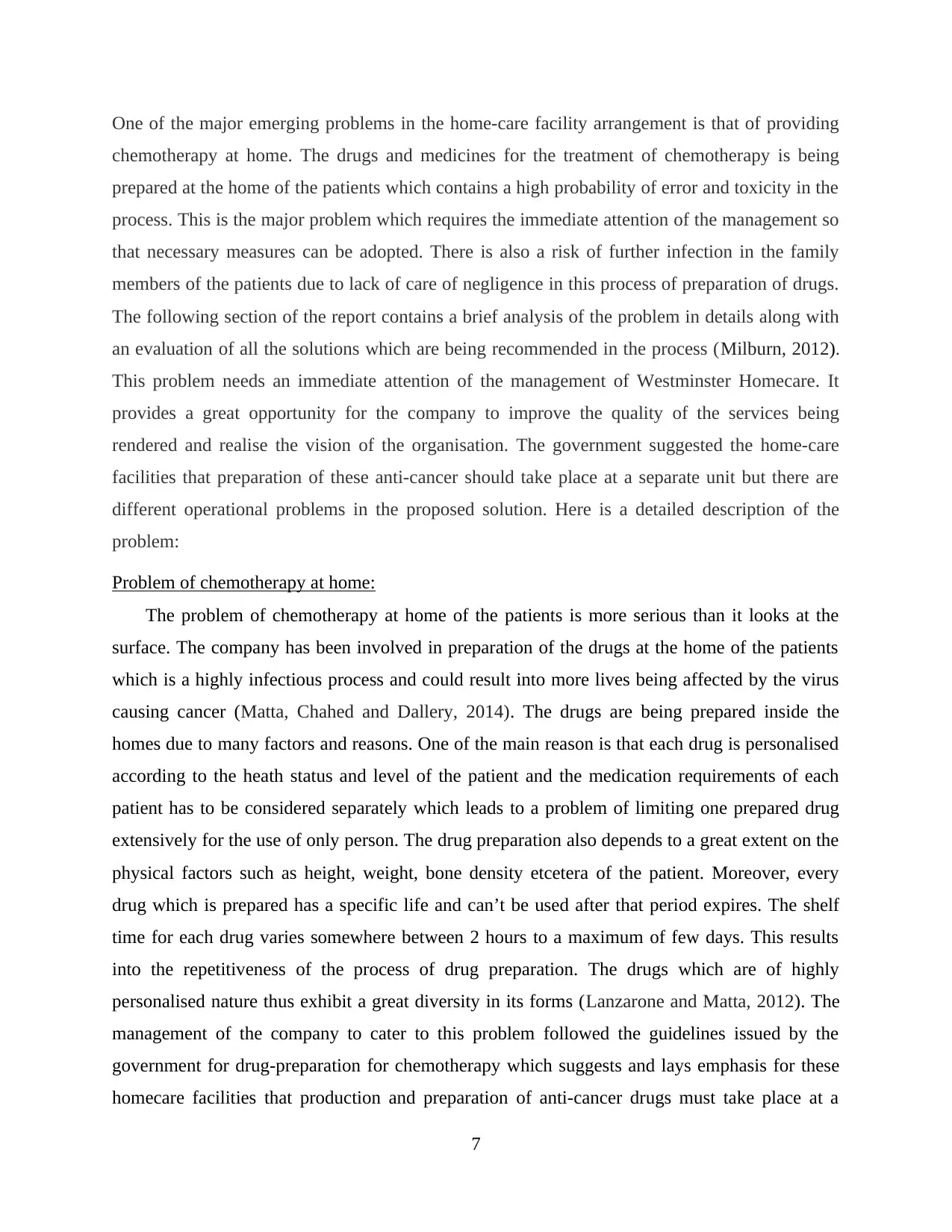
One of the major emerging problems in the home-care facility arrangement is that of providing
chemotherapy at home. The drugs and medicines for the treatment of chemotherapy is being
prepared at the home of the patients which contains a high probability of error and toxicity in the
process. This is the major problem which requires the immediate attention of the management so
that necessary measures can be adopted. There is also a risk of further infection in the family
members of the patients due to lack of care of negligence in this process of preparation of drugs.
The following section of the report contains a brief analysis of the problem in details along with
an evaluation of all the solutions which are being recommended in the process (Milburn, 2012).
This problem needs an immediate attention of the management of Westminster Homecare. It
provides a great opportunity for the company to improve the quality of the services being
rendered and realise the vision of the organisation. The government suggested the home-care
facilities that preparation of these anti-cancer should take place at a separate unit but there are
different operational problems in the proposed solution. Here is a detailed description of the
problem:
Problem of chemotherapy at home:
The problem of chemotherapy at home of the patients is more serious than it looks at the
surface. The company has been involved in preparation of the drugs at the home of the patients
which is a highly infectious process and could result into more lives being affected by the virus
causing cancer (Matta, Chahed and Dallery, 2014). The drugs are being prepared inside the
homes due to many factors and reasons. One of the main reason is that each drug is personalised
according to the heath status and level of the patient and the medication requirements of each
patient has to be considered separately which leads to a problem of limiting one prepared drug
extensively for the use of only person. The drug preparation also depends to a great extent on the
physical factors such as height, weight, bone density etcetera of the patient. Moreover, every
drug which is prepared has a specific life and can’t be used after that period expires. The shelf
time for each drug varies somewhere between 2 hours to a maximum of few days. This results
into the repetitiveness of the process of drug preparation. The drugs which are of highly
personalised nature thus exhibit a great diversity in its forms (Lanzarone and Matta, 2012). The
management of the company to cater to this problem followed the guidelines issued by the
government for drug-preparation for chemotherapy which suggests and lays emphasis for these
homecare facilities that production and preparation of anti-cancer drugs must take place at a
7
chemotherapy at home. The drugs and medicines for the treatment of chemotherapy is being
prepared at the home of the patients which contains a high probability of error and toxicity in the
process. This is the major problem which requires the immediate attention of the management so
that necessary measures can be adopted. There is also a risk of further infection in the family
members of the patients due to lack of care of negligence in this process of preparation of drugs.
The following section of the report contains a brief analysis of the problem in details along with
an evaluation of all the solutions which are being recommended in the process (Milburn, 2012).
This problem needs an immediate attention of the management of Westminster Homecare. It
provides a great opportunity for the company to improve the quality of the services being
rendered and realise the vision of the organisation. The government suggested the home-care
facilities that preparation of these anti-cancer should take place at a separate unit but there are
different operational problems in the proposed solution. Here is a detailed description of the
problem:
Problem of chemotherapy at home:
The problem of chemotherapy at home of the patients is more serious than it looks at the
surface. The company has been involved in preparation of the drugs at the home of the patients
which is a highly infectious process and could result into more lives being affected by the virus
causing cancer (Matta, Chahed and Dallery, 2014). The drugs are being prepared inside the
homes due to many factors and reasons. One of the main reason is that each drug is personalised
according to the heath status and level of the patient and the medication requirements of each
patient has to be considered separately which leads to a problem of limiting one prepared drug
extensively for the use of only person. The drug preparation also depends to a great extent on the
physical factors such as height, weight, bone density etcetera of the patient. Moreover, every
drug which is prepared has a specific life and can’t be used after that period expires. The shelf
time for each drug varies somewhere between 2 hours to a maximum of few days. This results
into the repetitiveness of the process of drug preparation. The drugs which are of highly
personalised nature thus exhibit a great diversity in its forms (Lanzarone and Matta, 2012). The
management of the company to cater to this problem followed the guidelines issued by the
government for drug-preparation for chemotherapy which suggests and lays emphasis for these
homecare facilities that production and preparation of anti-cancer drugs must take place at a
7
Paraphrase This Document
Need a fresh take? Get an instant paraphrase of this document with our AI Paraphraser
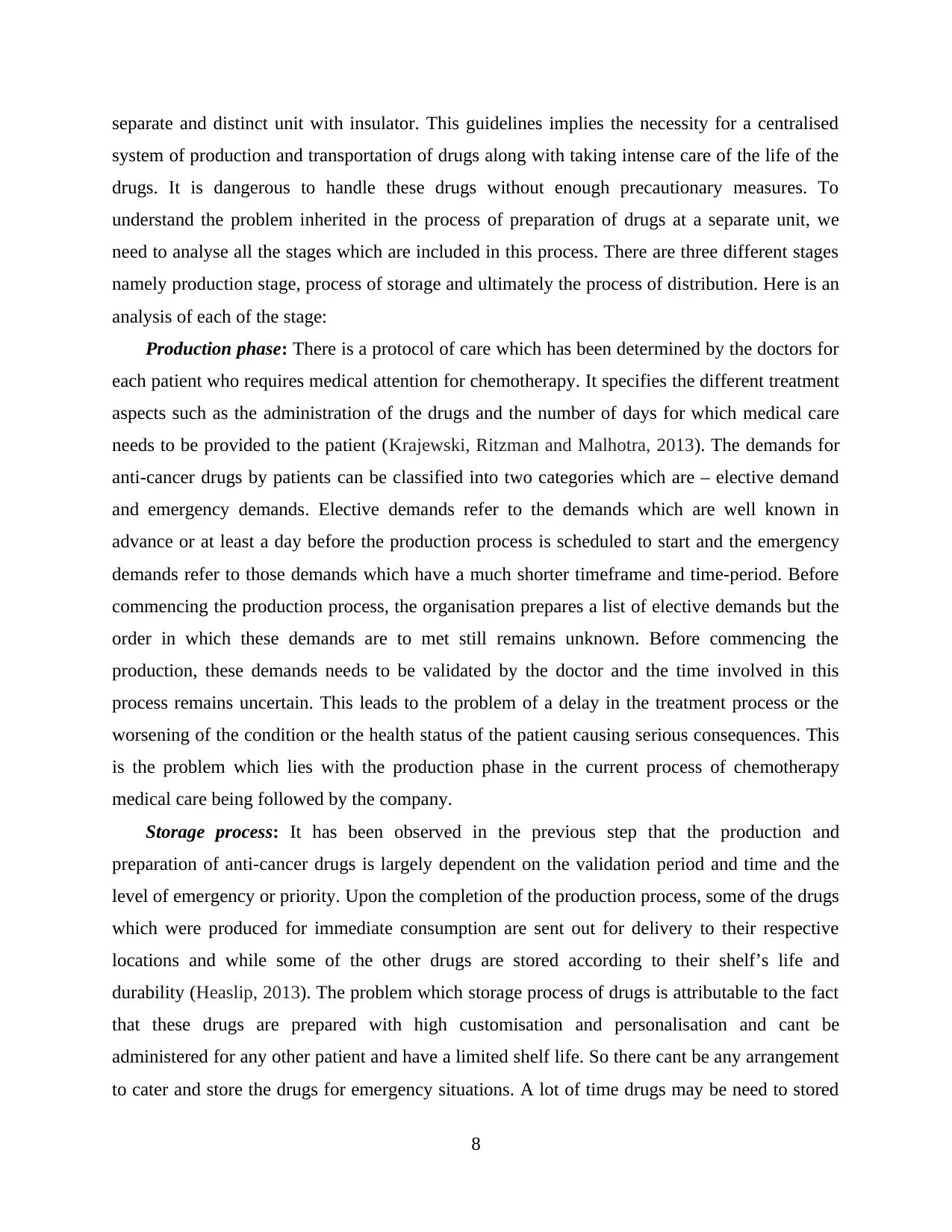
separate and distinct unit with insulator. This guidelines implies the necessity for a centralised
system of production and transportation of drugs along with taking intense care of the life of the
drugs. It is dangerous to handle these drugs without enough precautionary measures. To
understand the problem inherited in the process of preparation of drugs at a separate unit, we
need to analyse all the stages which are included in this process. There are three different stages
namely production stage, process of storage and ultimately the process of distribution. Here is an
analysis of each of the stage:
Production phase: There is a protocol of care which has been determined by the doctors for
each patient who requires medical attention for chemotherapy. It specifies the different treatment
aspects such as the administration of the drugs and the number of days for which medical care
needs to be provided to the patient (Krajewski, Ritzman and Malhotra, 2013). The demands for
anti-cancer drugs by patients can be classified into two categories which are – elective demand
and emergency demands. Elective demands refer to the demands which are well known in
advance or at least a day before the production process is scheduled to start and the emergency
demands refer to those demands which have a much shorter timeframe and time-period. Before
commencing the production process, the organisation prepares a list of elective demands but the
order in which these demands are to met still remains unknown. Before commencing the
production, these demands needs to be validated by the doctor and the time involved in this
process remains uncertain. This leads to the problem of a delay in the treatment process or the
worsening of the condition or the health status of the patient causing serious consequences. This
is the problem which lies with the production phase in the current process of chemotherapy
medical care being followed by the company.
Storage process: It has been observed in the previous step that the production and
preparation of anti-cancer drugs is largely dependent on the validation period and time and the
level of emergency or priority. Upon the completion of the production process, some of the drugs
which were produced for immediate consumption are sent out for delivery to their respective
locations and while some of the other drugs are stored according to their shelf’s life and
durability (Heaslip, 2013). The problem which storage process of drugs is attributable to the fact
that these drugs are prepared with high customisation and personalisation and cant be
administered for any other patient and have a limited shelf life. So there cant be any arrangement
to cater and store the drugs for emergency situations. A lot of time drugs may be need to stored
8
system of production and transportation of drugs along with taking intense care of the life of the
drugs. It is dangerous to handle these drugs without enough precautionary measures. To
understand the problem inherited in the process of preparation of drugs at a separate unit, we
need to analyse all the stages which are included in this process. There are three different stages
namely production stage, process of storage and ultimately the process of distribution. Here is an
analysis of each of the stage:
Production phase: There is a protocol of care which has been determined by the doctors for
each patient who requires medical attention for chemotherapy. It specifies the different treatment
aspects such as the administration of the drugs and the number of days for which medical care
needs to be provided to the patient (Krajewski, Ritzman and Malhotra, 2013). The demands for
anti-cancer drugs by patients can be classified into two categories which are – elective demand
and emergency demands. Elective demands refer to the demands which are well known in
advance or at least a day before the production process is scheduled to start and the emergency
demands refer to those demands which have a much shorter timeframe and time-period. Before
commencing the production process, the organisation prepares a list of elective demands but the
order in which these demands are to met still remains unknown. Before commencing the
production, these demands needs to be validated by the doctor and the time involved in this
process remains uncertain. This leads to the problem of a delay in the treatment process or the
worsening of the condition or the health status of the patient causing serious consequences. This
is the problem which lies with the production phase in the current process of chemotherapy
medical care being followed by the company.
Storage process: It has been observed in the previous step that the production and
preparation of anti-cancer drugs is largely dependent on the validation period and time and the
level of emergency or priority. Upon the completion of the production process, some of the drugs
which were produced for immediate consumption are sent out for delivery to their respective
locations and while some of the other drugs are stored according to their shelf’s life and
durability (Heaslip, 2013). The problem which storage process of drugs is attributable to the fact
that these drugs are prepared with high customisation and personalisation and cant be
administered for any other patient and have a limited shelf life. So there cant be any arrangement
to cater and store the drugs for emergency situations. A lot of time drugs may be need to stored
8
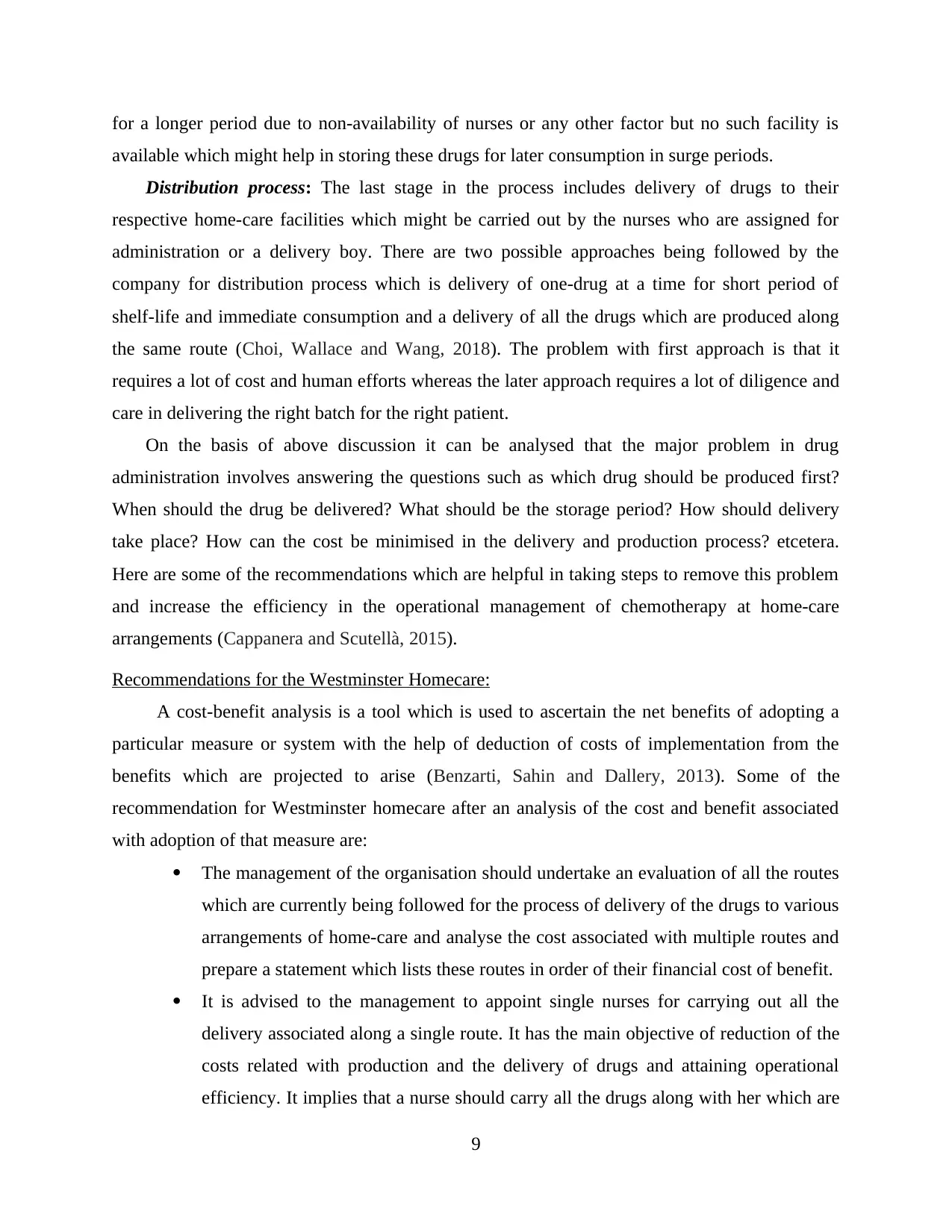
for a longer period due to non-availability of nurses or any other factor but no such facility is
available which might help in storing these drugs for later consumption in surge periods.
Distribution process: The last stage in the process includes delivery of drugs to their
respective home-care facilities which might be carried out by the nurses who are assigned for
administration or a delivery boy. There are two possible approaches being followed by the
company for distribution process which is delivery of one-drug at a time for short period of
shelf-life and immediate consumption and a delivery of all the drugs which are produced along
the same route (Choi, Wallace and Wang, 2018). The problem with first approach is that it
requires a lot of cost and human efforts whereas the later approach requires a lot of diligence and
care in delivering the right batch for the right patient.
On the basis of above discussion it can be analysed that the major problem in drug
administration involves answering the questions such as which drug should be produced first?
When should the drug be delivered? What should be the storage period? How should delivery
take place? How can the cost be minimised in the delivery and production process? etcetera.
Here are some of the recommendations which are helpful in taking steps to remove this problem
and increase the efficiency in the operational management of chemotherapy at home-care
arrangements (Cappanera and Scutellà, 2015).
Recommendations for the Westminster Homecare:
A cost-benefit analysis is a tool which is used to ascertain the net benefits of adopting a
particular measure or system with the help of deduction of costs of implementation from the
benefits which are projected to arise (Benzarti, Sahin and Dallery, 2013). Some of the
recommendation for Westminster homecare after an analysis of the cost and benefit associated
with adoption of that measure are:
The management of the organisation should undertake an evaluation of all the routes
which are currently being followed for the process of delivery of the drugs to various
arrangements of home-care and analyse the cost associated with multiple routes and
prepare a statement which lists these routes in order of their financial cost of benefit.
It is advised to the management to appoint single nurses for carrying out all the
delivery associated along a single route. It has the main objective of reduction of the
costs related with production and the delivery of drugs and attaining operational
efficiency. It implies that a nurse should carry all the drugs along with her which are
9
available which might help in storing these drugs for later consumption in surge periods.
Distribution process: The last stage in the process includes delivery of drugs to their
respective home-care facilities which might be carried out by the nurses who are assigned for
administration or a delivery boy. There are two possible approaches being followed by the
company for distribution process which is delivery of one-drug at a time for short period of
shelf-life and immediate consumption and a delivery of all the drugs which are produced along
the same route (Choi, Wallace and Wang, 2018). The problem with first approach is that it
requires a lot of cost and human efforts whereas the later approach requires a lot of diligence and
care in delivering the right batch for the right patient.
On the basis of above discussion it can be analysed that the major problem in drug
administration involves answering the questions such as which drug should be produced first?
When should the drug be delivered? What should be the storage period? How should delivery
take place? How can the cost be minimised in the delivery and production process? etcetera.
Here are some of the recommendations which are helpful in taking steps to remove this problem
and increase the efficiency in the operational management of chemotherapy at home-care
arrangements (Cappanera and Scutellà, 2015).
Recommendations for the Westminster Homecare:
A cost-benefit analysis is a tool which is used to ascertain the net benefits of adopting a
particular measure or system with the help of deduction of costs of implementation from the
benefits which are projected to arise (Benzarti, Sahin and Dallery, 2013). Some of the
recommendation for Westminster homecare after an analysis of the cost and benefit associated
with adoption of that measure are:
The management of the organisation should undertake an evaluation of all the routes
which are currently being followed for the process of delivery of the drugs to various
arrangements of home-care and analyse the cost associated with multiple routes and
prepare a statement which lists these routes in order of their financial cost of benefit.
It is advised to the management to appoint single nurses for carrying out all the
delivery associated along a single route. It has the main objective of reduction of the
costs related with production and the delivery of drugs and attaining operational
efficiency. It implies that a nurse should carry all the drugs along with her which are
9
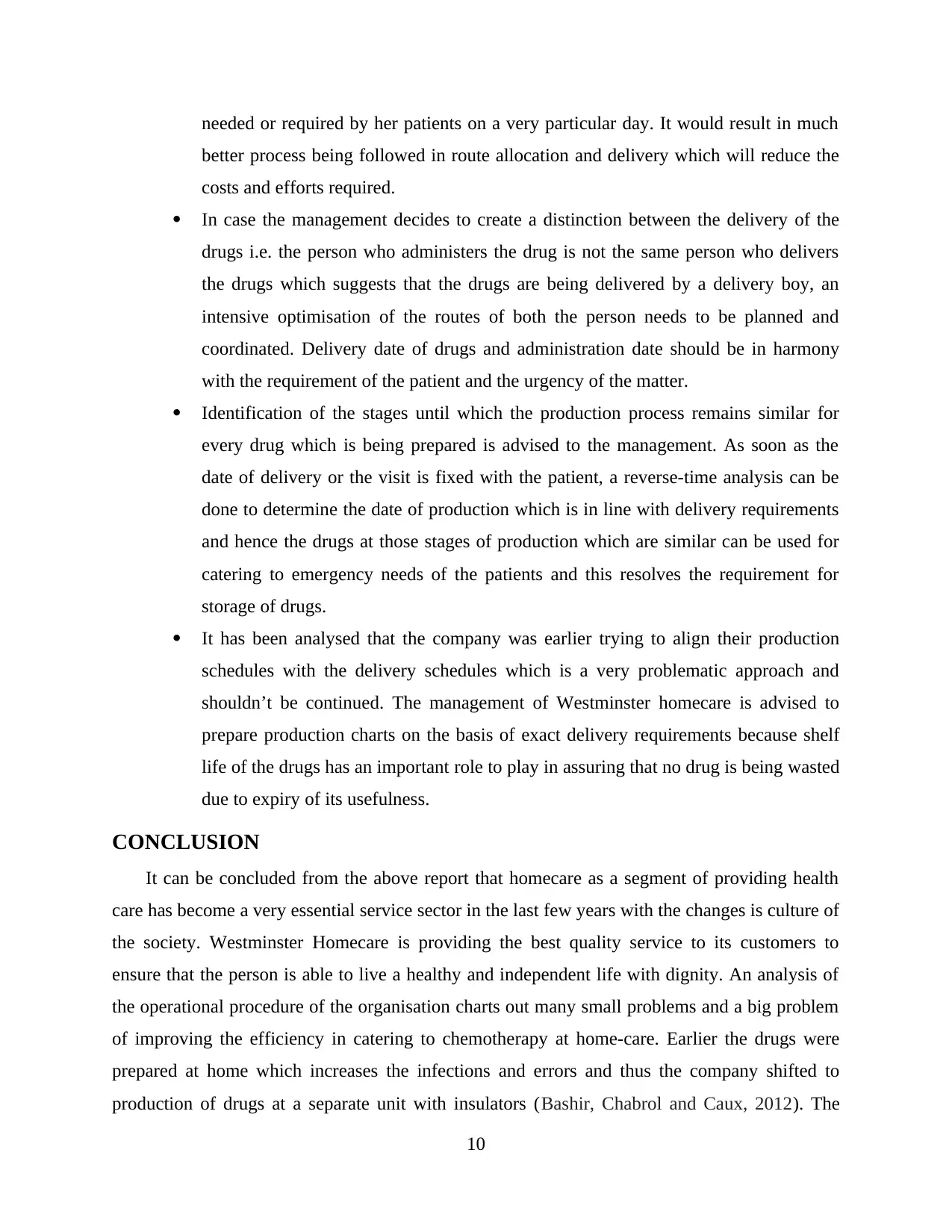
needed or required by her patients on a very particular day. It would result in much
better process being followed in route allocation and delivery which will reduce the
costs and efforts required.
In case the management decides to create a distinction between the delivery of the
drugs i.e. the person who administers the drug is not the same person who delivers
the drugs which suggests that the drugs are being delivered by a delivery boy, an
intensive optimisation of the routes of both the person needs to be planned and
coordinated. Delivery date of drugs and administration date should be in harmony
with the requirement of the patient and the urgency of the matter.
Identification of the stages until which the production process remains similar for
every drug which is being prepared is advised to the management. As soon as the
date of delivery or the visit is fixed with the patient, a reverse-time analysis can be
done to determine the date of production which is in line with delivery requirements
and hence the drugs at those stages of production which are similar can be used for
catering to emergency needs of the patients and this resolves the requirement for
storage of drugs.
It has been analysed that the company was earlier trying to align their production
schedules with the delivery schedules which is a very problematic approach and
shouldn’t be continued. The management of Westminster homecare is advised to
prepare production charts on the basis of exact delivery requirements because shelf
life of the drugs has an important role to play in assuring that no drug is being wasted
due to expiry of its usefulness.
CONCLUSION
It can be concluded from the above report that homecare as a segment of providing health
care has become a very essential service sector in the last few years with the changes is culture of
the society. Westminster Homecare is providing the best quality service to its customers to
ensure that the person is able to live a healthy and independent life with dignity. An analysis of
the operational procedure of the organisation charts out many small problems and a big problem
of improving the efficiency in catering to chemotherapy at home-care. Earlier the drugs were
prepared at home which increases the infections and errors and thus the company shifted to
production of drugs at a separate unit with insulators (Bashir, Chabrol and Caux, 2012). The
10
better process being followed in route allocation and delivery which will reduce the
costs and efforts required.
In case the management decides to create a distinction between the delivery of the
drugs i.e. the person who administers the drug is not the same person who delivers
the drugs which suggests that the drugs are being delivered by a delivery boy, an
intensive optimisation of the routes of both the person needs to be planned and
coordinated. Delivery date of drugs and administration date should be in harmony
with the requirement of the patient and the urgency of the matter.
Identification of the stages until which the production process remains similar for
every drug which is being prepared is advised to the management. As soon as the
date of delivery or the visit is fixed with the patient, a reverse-time analysis can be
done to determine the date of production which is in line with delivery requirements
and hence the drugs at those stages of production which are similar can be used for
catering to emergency needs of the patients and this resolves the requirement for
storage of drugs.
It has been analysed that the company was earlier trying to align their production
schedules with the delivery schedules which is a very problematic approach and
shouldn’t be continued. The management of Westminster homecare is advised to
prepare production charts on the basis of exact delivery requirements because shelf
life of the drugs has an important role to play in assuring that no drug is being wasted
due to expiry of its usefulness.
CONCLUSION
It can be concluded from the above report that homecare as a segment of providing health
care has become a very essential service sector in the last few years with the changes is culture of
the society. Westminster Homecare is providing the best quality service to its customers to
ensure that the person is able to live a healthy and independent life with dignity. An analysis of
the operational procedure of the organisation charts out many small problems and a big problem
of improving the efficiency in catering to chemotherapy at home-care. Earlier the drugs were
prepared at home which increases the infections and errors and thus the company shifted to
production of drugs at a separate unit with insulators (Bashir, Chabrol and Caux, 2012). The
10
Secure Best Marks with AI Grader
Need help grading? Try our AI Grader for instant feedback on your assignments.
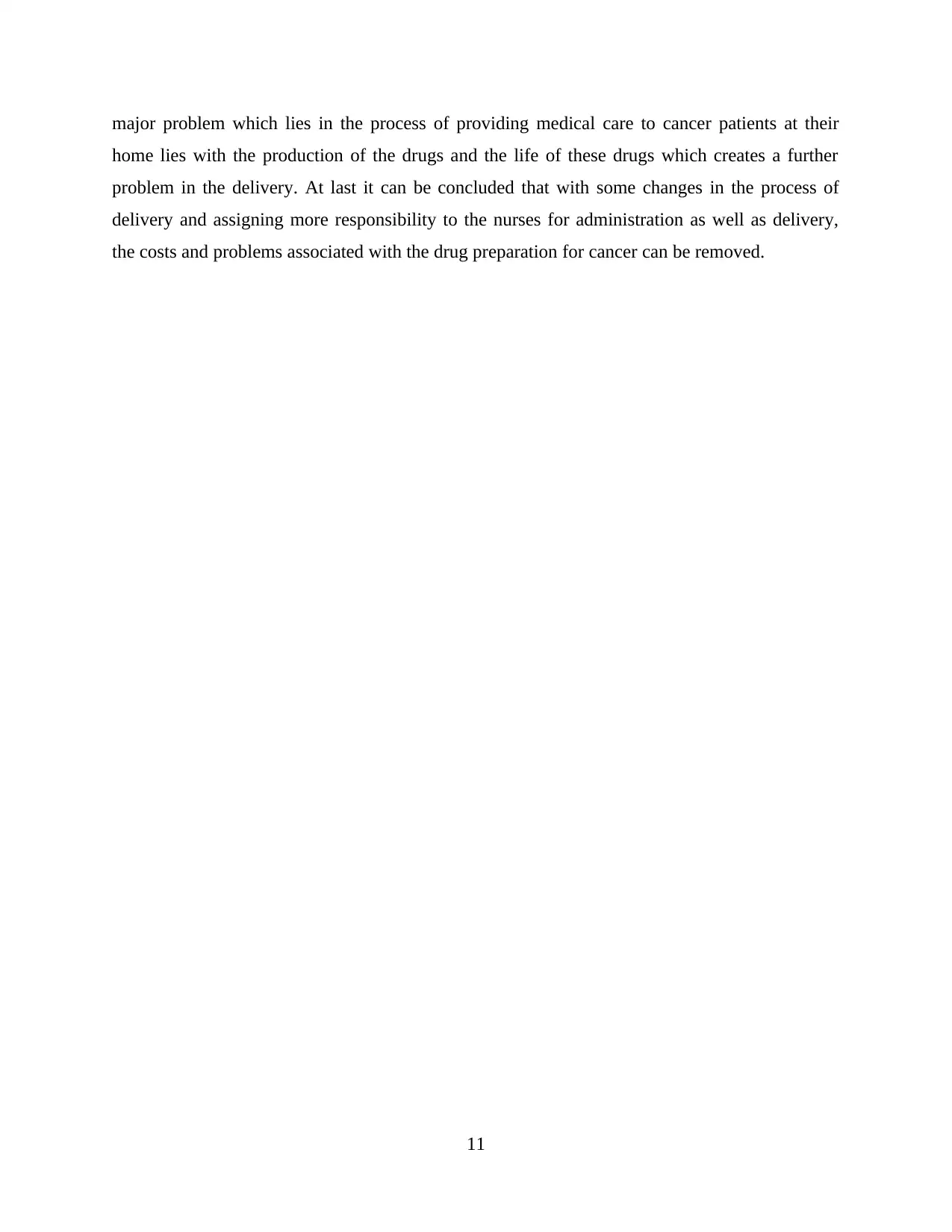
major problem which lies in the process of providing medical care to cancer patients at their
home lies with the production of the drugs and the life of these drugs which creates a further
problem in the delivery. At last it can be concluded that with some changes in the process of
delivery and assigning more responsibility to the nurses for administration as well as delivery,
the costs and problems associated with the drug preparation for cancer can be removed.
11
home lies with the production of the drugs and the life of these drugs which creates a further
problem in the delivery. At last it can be concluded that with some changes in the process of
delivery and assigning more responsibility to the nurses for administration as well as delivery,
the costs and problems associated with the drug preparation for cancer can be removed.
11
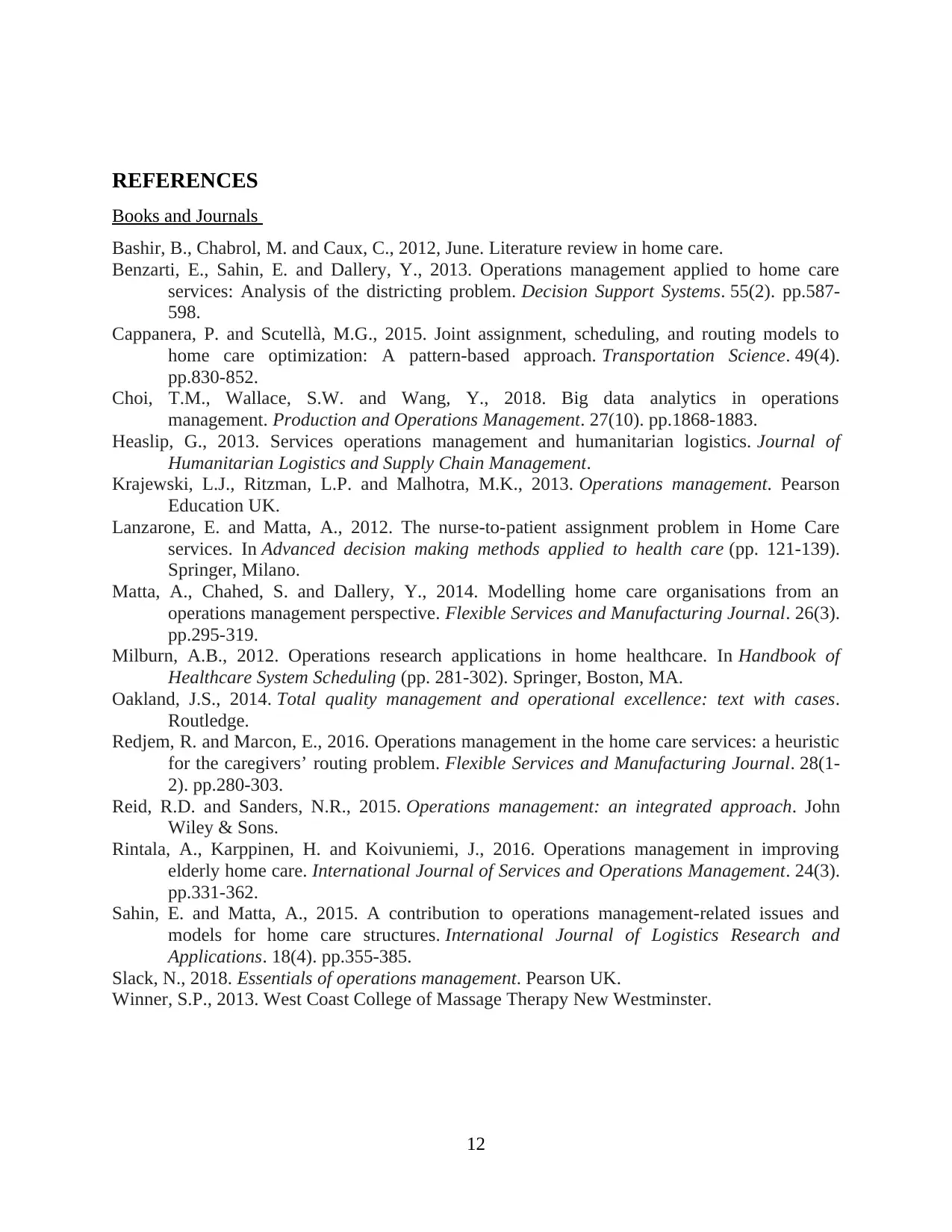
REFERENCES
Books and Journals
Bashir, B., Chabrol, M. and Caux, C., 2012, June. Literature review in home care.
Benzarti, E., Sahin, E. and Dallery, Y., 2013. Operations management applied to home care
services: Analysis of the districting problem. Decision Support Systems. 55(2). pp.587-
598.
Cappanera, P. and Scutellà, M.G., 2015. Joint assignment, scheduling, and routing models to
home care optimization: A pattern-based approach. Transportation Science. 49(4).
pp.830-852.
Choi, T.M., Wallace, S.W. and Wang, Y., 2018. Big data analytics in operations
management. Production and Operations Management. 27(10). pp.1868-1883.
Heaslip, G., 2013. Services operations management and humanitarian logistics. Journal of
Humanitarian Logistics and Supply Chain Management.
Krajewski, L.J., Ritzman, L.P. and Malhotra, M.K., 2013. Operations management. Pearson
Education UK.
Lanzarone, E. and Matta, A., 2012. The nurse-to-patient assignment problem in Home Care
services. In Advanced decision making methods applied to health care (pp. 121-139).
Springer, Milano.
Matta, A., Chahed, S. and Dallery, Y., 2014. Modelling home care organisations from an
operations management perspective. Flexible Services and Manufacturing Journal. 26(3).
pp.295-319.
Milburn, A.B., 2012. Operations research applications in home healthcare. In Handbook of
Healthcare System Scheduling (pp. 281-302). Springer, Boston, MA.
Oakland, J.S., 2014. Total quality management and operational excellence: text with cases.
Routledge.
Redjem, R. and Marcon, E., 2016. Operations management in the home care services: a heuristic
for the caregivers’ routing problem. Flexible Services and Manufacturing Journal. 28(1-
2). pp.280-303.
Reid, R.D. and Sanders, N.R., 2015. Operations management: an integrated approach. John
Wiley & Sons.
Rintala, A., Karppinen, H. and Koivuniemi, J., 2016. Operations management in improving
elderly home care. International Journal of Services and Operations Management. 24(3).
pp.331-362.
Sahin, E. and Matta, A., 2015. A contribution to operations management-related issues and
models for home care structures. International Journal of Logistics Research and
Applications. 18(4). pp.355-385.
Slack, N., 2018. Essentials of operations management. Pearson UK.
Winner, S.P., 2013. West Coast College of Massage Therapy New Westminster.
12
Books and Journals
Bashir, B., Chabrol, M. and Caux, C., 2012, June. Literature review in home care.
Benzarti, E., Sahin, E. and Dallery, Y., 2013. Operations management applied to home care
services: Analysis of the districting problem. Decision Support Systems. 55(2). pp.587-
598.
Cappanera, P. and Scutellà, M.G., 2015. Joint assignment, scheduling, and routing models to
home care optimization: A pattern-based approach. Transportation Science. 49(4).
pp.830-852.
Choi, T.M., Wallace, S.W. and Wang, Y., 2018. Big data analytics in operations
management. Production and Operations Management. 27(10). pp.1868-1883.
Heaslip, G., 2013. Services operations management and humanitarian logistics. Journal of
Humanitarian Logistics and Supply Chain Management.
Krajewski, L.J., Ritzman, L.P. and Malhotra, M.K., 2013. Operations management. Pearson
Education UK.
Lanzarone, E. and Matta, A., 2012. The nurse-to-patient assignment problem in Home Care
services. In Advanced decision making methods applied to health care (pp. 121-139).
Springer, Milano.
Matta, A., Chahed, S. and Dallery, Y., 2014. Modelling home care organisations from an
operations management perspective. Flexible Services and Manufacturing Journal. 26(3).
pp.295-319.
Milburn, A.B., 2012. Operations research applications in home healthcare. In Handbook of
Healthcare System Scheduling (pp. 281-302). Springer, Boston, MA.
Oakland, J.S., 2014. Total quality management and operational excellence: text with cases.
Routledge.
Redjem, R. and Marcon, E., 2016. Operations management in the home care services: a heuristic
for the caregivers’ routing problem. Flexible Services and Manufacturing Journal. 28(1-
2). pp.280-303.
Reid, R.D. and Sanders, N.R., 2015. Operations management: an integrated approach. John
Wiley & Sons.
Rintala, A., Karppinen, H. and Koivuniemi, J., 2016. Operations management in improving
elderly home care. International Journal of Services and Operations Management. 24(3).
pp.331-362.
Sahin, E. and Matta, A., 2015. A contribution to operations management-related issues and
models for home care structures. International Journal of Logistics Research and
Applications. 18(4). pp.355-385.
Slack, N., 2018. Essentials of operations management. Pearson UK.
Winner, S.P., 2013. West Coast College of Massage Therapy New Westminster.
12
1 out of 12
Related Documents
Your All-in-One AI-Powered Toolkit for Academic Success.
+13062052269
info@desklib.com
Available 24*7 on WhatsApp / Email
![[object Object]](/_next/static/media/star-bottom.7253800d.svg)
Unlock your academic potential
© 2024 | Zucol Services PVT LTD | All rights reserved.





